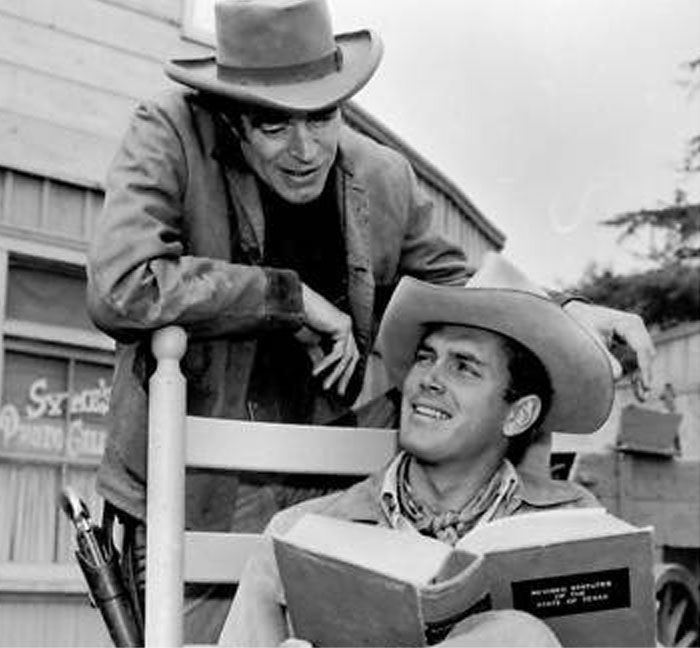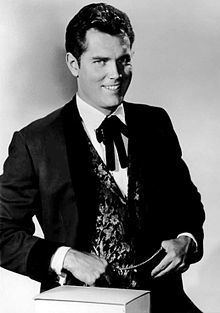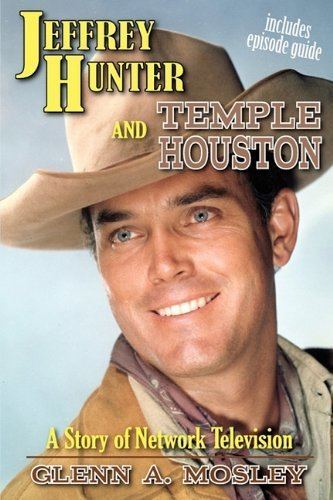7.4 /10 1 Votes7.4
6.6/10 TV Original language(s) English Final episode date 2 April 1964 | 8.3/10 IMDb Country of origin United States First episode date 19 September 1963 Number of seasons 1 | |||||||||||||||||||||||||||||||||
 | ||||||||||||||||||||||||||||||||||
Genre WesternLegal dramaComedy Directed by Leslie H. MartinsonWilliam ConradRobert TottenIrving J. MooreAlvin GanzerRobert D. Webb Starring Jeffrey HunterJack ElamJames BestFrank FergusonChubby JohnsonMary Wickes Cast Similar The Dakotas, Colt 45, The Alaskans, Lawman, Sugarfoot | ||||||||||||||||||||||||||||||||||
the man from galveston and temple houston tribute
Temple Houston is a 1963–1964 NBC television series considered "the first attempt ... to produce an hour-long western series with the main character being an attorney in the formal sense." Temple Houston was the only program which Jack Webb sold to a network during his ten months as the head of production at Warner Bros. Television. It was also the lone series in which actor Jeffrey Hunter played a regular part. The series' supporting cast features Jack Elam and Chubby Johnson.
Contents
- the man from galveston and temple houston tribute
- Overview
- The making of the series
- The Hunter and Houston parallel
- Cast
- Pilot
- Cancellation
- After cancellation
- References

Overview

Temple Houston is based loosely on the career of the real-life circuit-riding lawyer Temple Lea Houston (1860–1905), son of the more famous Sam Houston. Little, however, binds all the episodes together under a common framework. The series variously cast the characters and situations in both an overtly humorous and a deadly serious light. Writer Francis M. Nevin asserts of the first episode entitled "The Twisted Rope": "Clearly, the concept here is Perry Mason out West", going so far as to note that Temple Houston's court opponent "apes Hamilton Burger by accusing Houston of 'prolonging this trial with a lot of dramatic nonsense'". Later episodes turned Houston into more of a detective than a lawyer. Over the course of the series, the bulk of the narrative sees Houston actually gathering evidence, rather than trying cases. In the end, the series largely eschewed criminal law in favor of overtly humorous plots, such as in the episode "The Law and Big Annie", in which Houston uses his legal expertise to help a friend decide what to do after he inherits an elephant.

The producers tried to avoid any storylines that would embarrass the two surviving children of Temple Houston who were still living when the series aired.
The making of the series
Temple Houston was rushed onto the 1963 schedule in only four weeks after a previously planned drama, The Robert Taylor Show, based on case files of the former United States Department of Health, Education and Welfare, was abandoned with four unaired episodes. In addition, the Temple Houston pilot episode was unusable for the introduction to the new series because James Coburn, who played the secondary character, a gunslinger turned U.S. marshal, would not accept a role in a series. Coburn's character was hence assumed by Jack Elam as George Taggart. A leading character actor in film and television, Elam had just left the short-lived ABC/Warner Brothers western, The Dakotas, which had replaced Clint Walker's long-running Cheyenne series early in 1963.
On orders from Jack Webb, episodes were put together in two or three days each, something previously thought impossible in television production. Work began on August 7, 1963, with the initial airing set for September 19. Jimmy Lydon, a former child actor, adult actor, and producer who was at the time with WB, recalled that Webb told the staff: "Fellas, I just sold Temple Houston. We gotta be on the air in four weeks, we can't use the pilot, we have no scripts, no nothing - do it!" Lydon recalled the team having worked around the clock to get Temple Houston on the air. Co-producer William Conrad directed six episodes, two scripts simultaneously on two different soundstages at WB. "We bicycled Jeff (Hunter) and (Jack) Elam between the two companies, and Bill shot 'em both in four-and-a-half days. Two complete one-hour shows!" said Lydon.
In a 1965 interview, Hunter described the situation:
In the first place, we had no time to prepare for it. I was notified on July 17 to be ready to start August 7 for an October air date. When we reached the screen we did not have a single segment ready. It was done so fast the writers never got a chance to know what it was all about. We all wanted to follow the line indicated by the pilot film, which we thought would make a charming series. NBC, however, favored making it serious.
Two Temple Houston directors, Robert Totten and Irving J. Moore, worked on Gunsmoke as well. Character actress Mary Wickes was cast in several episodes as Ida Goff, and Frank Ferguson, formerly Gus the ranch hand on My Friend Flicka, played Judge Gurney.
The Hunter and Houston parallel
The unused pilot with Hunter cast as lawyer Timothy Higgins, was released in theaters in December 1963 as The Man from Galveston. Hopeful of success in the series and being paid $5,000 per episode, Jeffrey Hunter, a native of New Orleans, Louisiana, described the historic figure that he played as "one of the finest lawyers in the last part of the 19th century." Indeed, Temple Houston at the age of twenty was the youngest practicing lawyer in Texas. He was the county attorney in Brazoria County south of Houston, until he accepted appointment as the district attorney of the 35th Judicial District, which then encompassed twenty-six counties in the Texas Panhandle, based in the frontier community of Mobeetie in Wheeler County.
As a member of the Texas State Senate from 1885 to 1889, Temple Houston became involved with a dispute with the legendary cattleman and rancher Charles Goodnight, sometimes called "the father of the Texas Panhandle". At issue was fencing of grasslands to accommodate large ranchers. Houston sided unsuccessfully with the smaller ranchers who wanted free grassland. One historian described the real Temple Houston as "a flamboyant figure in his black frock coat and shoulder-length auburn hair topped off with a white Stetson. He liked to lace his arguments with literary allusions and could enthrall a courtroom or legislative chamber." Houston gave the dedication in 1888 for the new state capitol building in Austin, Texas. He subsequently worked for Oklahoma statehood, which came to fruition two years after his death. Houston lost races for Texas attorney general and territorial governor of Oklahoma. In the series, Houston located his clients by traveling with the circuit court and being available as needed.
Jeffrey Hunter described the Temple Houston that he sought to emulate as having "many sides to his character. He was a flamboyant orator; he was a bit of a dandy; he was tough; he was gentle; he was an excellent marksman," all features which gave the series greater latitude with a western format. Houston was also described as follows:
He would ride, shoot, fight, drink, and love with the best of them and maybe better than most. The modesty that he displays in day-to-day life would disappear as soon as he enters a courtroom, becoming the flamboyant attorney famous throughout the American Southwest
Though Hunter was an optimistic person and a collegial colleague on the set, Temple Houston proved illusory for his long-term career prospects. Hunter thought that the series had found its voice beginning with the twelfth episode, "Enough Rope", by having adopted the light-hearted approach of ABC's former Maverick western series. As Hunter explained the change in format, the series was "conceived in humor and delivered in dead seriousness. Then, about halfway through the season, NBC decided to return to the tongue-in-cheek approach. By that time it was too late. The big joke around town was that the series was about a synagogue in Texas."
In taking the Temple Houston role, Hunter was compelled by a scheduling conflict to bow out of John Ford's final western film, Cheyenne Autumn. Hunter died in 1969 at the age of forty-two, having undergone unsuccessful brain surgery following a stroke that had been apparently triggered by a household fall. Oddly, the Hunter-Houston parallel prevailed in death too: Houston succumbed to a brain hemorrhage just three days after his 45th birthday.
Cast
Jeffrey Hunter as Temple Lea Houston
Jack Elam as George Taggart
Frank Ferguson as Judge Gurney
Chubby Johnson as Concho
Mary Wickes as Ida Goff
Pilot
The earliest known conceptual documents for Temple Houston date back to 1957. It took about six years for a pilot to be filmed. That pilot, The Man From Galveston, was filmed in March 1963, but was never broadcast on television. Instead, the 57-minute film was released theatrically late in 1963. The series used a different cast from the movie pilot. Jeffrey Hunter was the only cast member to star in both pilot and series, although his character was re-dubbed Timothy Higgins in the pilot when it was released as a theatrical film.
The series was produced by Warner Bros. Television and Apollo Productions, a company co-owned by star Jeffrey Hunter, who had demanded to produce it in exchange for a film and television commitment to Warner Bros.
By December 1963, the series was rated 31st of the 32 new shows that season. NBC then ordered a switch back to more humorous stories. but the change merely allowed the series to continue to the end of the season.
Cancellation
Temple Houston was pulled after one season of twenty-six episodes. Hunter later indicated that he thought the series failed because of an inability to establish a consistent tone.
After cancellation
Because the show produced so few episodes, it had little presence on the domestic syndication market. However, it appears to have enjoyed limited international syndication. The series was shown in Japan in 1963, and on Australian regional television station GTS-4 in 1974. In the United Kingdom the program was shown on BBC One television between October 1964 and July 1965, inspiring one of the few pieces of memorabilia from the show—a 1965 British annual.
